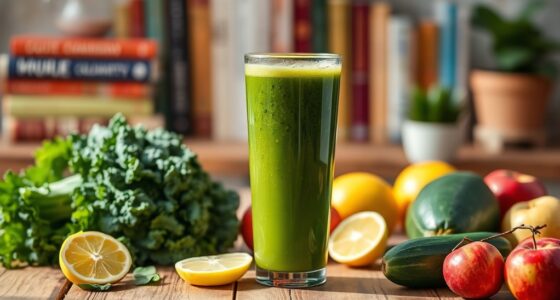I absolutely love blueberries and am always looking for new ways to incorporate them into my meals. Homemade blueberry juice is one of my favorite ways to enjoy this delicious fruit.
Not only is it incredibly refreshing and delicious, but it’s also packed with health benefits. Blueberries are a true superfood, containing a wealth of vitamins, minerals, and antioxidants that can help boost your immune system, improve your heart health, and even protect against cancer. Plus, they’re low in calories and high in fiber, making them an excellent addition to any healthy diet.
In this article, I’ll share my favorite recipe for making blueberry juice at home, along with some tips for customizing it to your taste and using it in recipes. So let’s get started!
Key Takeaways
- Blueberry juice is a delicious and healthy way to incorporate blueberries into your diet.
- The basic recipe requires fresh blueberries, water, and a blender, and can be customized with natural sweeteners like honey and maple syrup, as well as spices and other fruits.
- Concentrating the juice removes some fiber and nutrients, but it is still low in calories and high in fiber.
- After making blueberry juice, it should be refrigerated as soon as possible, and frozen juice can last for several months.
Benefits of Blueberry Juice for Health
You’re gonna love how blueberry juice can improve your health with its high levels of antioxidants and anti-inflammatory properties.
The antioxidant properties of blueberries help to protect the body against damage caused by free radicals, which are unstable molecules that can damage cells and contribute to the development of chronic diseases.
Additionally, blueberries are immune system boosters because they contain high levels of vitamin C, which is an essential nutrient for the immune system.
In order to reap the maximum benefits from blueberry juice, it’s important to choose the right blueberries.
Look for blueberries that are plump, firm, and have a deep blue color.
Avoid blueberries that are soft, wrinkled, or have a dull color.
By choosing the right blueberries, you can ensure that you’re getting the most out of your blueberry juice.
Choosing the Right Blueberries
Feeling like a true blueberry connoisseur, you’ll want to select the perfect type of berry for your creation. When it comes to making blueberry juice, not all blueberries are created equal. There are two main types of blueberries: highbush and lowbush. Highbush blueberries are larger, plumper, and sweeter than lowbush blueberries. They are the most commonly grown and harvested blueberries and are perfect for making juice. On the other hand, lowbush blueberries are smaller, tarter, and have a more intense flavor. They are typically used for baking and making preserves rather than juice.
The best time to buy blueberries for juice making is during the peak of their season, which is from late June to early August. This is when blueberries are at their sweetest and most flavorful. Look for blueberries that are firm, plump, and have a deep blue color. Avoid blueberries that are soft, mushy, or have a dull color as they may be overripe or spoiled. With the right type of blueberries and timing, you can ensure that your blueberry juice will be bursting with flavor and health benefits. And with that, let’s move on to the basic blueberry juice recipe.
Basic Blueberry Juice Recipe
To whip up this deliciously fruity drink, all you need are fresh blueberries, water, and a blender. Start by rinsing the blueberries thoroughly and removing any stems or leaves. Then, add the blueberries and water to the blender. Use a high-speed setting to blend the mixture until it becomes a smooth, purple liquid.
There are many variations of blueberry juice, but this basic recipe is a great starting point for experimenting with different flavors. For a sweeter taste, try adding honey or maple syrup. You could also blend in other fruits such as strawberries or raspberries for a berry medley juice.
Once your blueberry juice is ready, pour it into a glass and serve it chilled. Blueberry juice is a great addition to any breakfast or as a refreshing midday pick-me-up.
Next, let’s talk about adding sweeteners to take your blueberry juice to the next level.
Adding Sweeteners
If you’re looking for a way to enhance the taste of your blueberry juice, adding natural sweeteners is a great option. Instead of using processed white sugar, consider using sweetener alternatives like honey or maple syrup.
These natural sweeteners not only add a delicious taste to your juice, but they also contain essential nutrients that are beneficial to your health. Honey, for instance, contains antioxidants and has antibacterial properties that can help boost your immune system. Maple syrup, on the other hand, is rich in minerals like manganese and zinc that play a crucial role in maintaining a healthy body.
By using these natural sweetener alternatives, you can enjoy a sweet and healthy blueberry juice that your taste buds and body will love.
Now that you’ve learned how to sweeten your blueberry juice, it’s time to move on to the next step of customizing your drink. There are many different ways to create a customized blueberry juice that suits your individual taste preferences and health needs. Let’s explore these options in the next section.
Customizing Your Blueberry Juice
Now it’s time for you to get creative and personalize your berrylicious beverage to your liking! There are plenty of ways to customize the flavor of your blueberry juice.
If you’re looking for a bit of warmth and depth, try adding spices like cinnamon or nutmeg. These spices not only offer a delicious flavor but also have numerous health benefits, such as reducing inflammation and improving brain function.
If you prefer your juice to be on the sweeter side, consider adding a natural sweetener like honey or agave nectar. This will give your juice a touch of sweetness without compromising its nutrition value.
Alternatively, you can also add other fruits like strawberries or raspberries to give your juice a unique twist. With so many options, the possibilities are endless!
Now that you’ve customized your blueberry juice to your liking, it’s time to move on to the next step: making blueberry juice concentrate.
Making Blueberry Juice Concentrate
You’ll discover that concentrating your blueberry juice is a simple process that intensifies its flavor and makes it easier to store for longer periods of time. To make blueberry juice concentrate, start by washing and rinsing your blueberries thoroughly.
Next, add them to a blender or food processor and blend until they become a smooth puree. Once you have the puree, pour it into a saucepan and heat it over medium heat until it starts to bubble. Reduce the heat to low and let it simmer for about 30 minutes, stirring occasionally.
This process will help to evaporate the excess water and concentrate the flavor. When it’s done, let it cool before straining it through a fine-mesh sieve or cheesecloth. The resulting liquid is your blueberry juice concentrate.
While blueberry juice concentrate offers some benefits such as being able to store for longer periods and intensifying the flavor, there are some drawbacks. Concentrating the juice removes some of the fiber and other nutrients found in whole blueberries. Additionally, making blueberry juice without a juicer can be time-consuming and messy.
To store your blueberry juice, transfer it to an airtight container and refrigerate it for up to one week or freeze it for up to six months. Alternatively, you can use the concentrate as a base for smoothies, cocktails, or other beverages.
Storing Blueberry Juice
When it comes to storing blueberry juice, there are a few key points to keep in mind. First and foremost, it’s important to refrigerate the juice as soon as possible after it’s been made. This will help preserve its freshness and prevent it from spoiling.
Additionally, if you’re looking to extend the shelf life of your blueberry juice, freezing it is a great option. Properly stored in an airtight container, frozen blueberry juice can last for several months.
Refrigeration
To keep your blueberry juice fresh, make sure to store it in the refrigerator. Did you know that blueberries can last up to two weeks in the fridge?
Here are some reasons why refrigeration is the best way to store blueberry juice:
- It preserves the nutrients and health benefits of the blueberries.
- It keeps the juice fresh and prevents spoilage.
- It makes the juice taste better and more refreshing when served chilled.
- It allows you to enjoy the juice anytime you want without worrying about it going bad.
- It makes it easy to incorporate blueberry juice into your daily diet.
Using blueberries for baking is a great way to enjoy their sweet flavor and health benefits, but don’t forget about the many different ways to consume blueberry juice. Whether you drink it on its own or mix it into smoothies, blueberry juice is a delicious and nutritious addition to your diet.
Now, let’s move on to the next step – freezing your blueberry juice.
Freezing
Freezing is a convenient way to preserve the freshness and flavor of your blueberries. There are a few different freezing methods you can use, but I prefer to spread my blueberries out on a baking sheet and freeze them before transferring them to a freezer-safe bag or container. This ensures that they freeze individually and won’t stick together, making it easier to portion out the amount I need for smoothies, baking, or just snacking.
When you’re ready to use your frozen blueberries, it’s important to thaw them properly to maintain their texture and taste. I recommend thawing them in the fridge overnight or at room temperature for a few hours. Avoid thawing them in the microwave as this can cause them to become mushy.
Once thawed, you can use them in any recipe that calls for fresh blueberries. Freezing is a great way to extend the shelf life of your blueberries and ensure you always have them on hand for your favorite recipes.
Speaking of shelf life, let’s talk about how long your frozen blueberries will last in the freezer.
Shelf Life
The shelf life of frozen blueberries is like a ticking time bomb, slowly counting down until the flavor and texture begin to deteriorate. To extend the shelf life of your blueberries, it’s important to store them properly.
First, make sure they’re washed and thoroughly dried before freezing. Then, place them in airtight containers or freezer bags, removing as much air as possible to prevent freezer burn. Blueberries can last up to six months in the freezer if stored correctly.
Another tip for extending shelf life is to freeze the blueberries in single layers before placing them in containers or bags. This will prevent the berries from clumping together and make it easier to use them in recipes later on.
By following these proper storage techniques, you can enjoy the health benefits of blueberries all year round.
Now, let’s move on to using blueberry juice in recipes.
Using Blueberry Juice in Recipes
When incorporating blueberry juice into your culinary creations, you’ll find that it adds a burst of sweet and tangy flavor that perfectly complements both sweet and savory dishes. Blueberry juice can be used in a variety of ways, including as a base for blueberry juice cocktails or as an ingredient in baking recipes.
To get you started, here’s a table with some ideas for incorporating blueberry juice into your cooking and baking:
| Recipe Type | Blueberry Juice Usage |
|---|---|
| Cocktails | Blueberry Margarita, Blueberry Lemonade, Blueberry Mule |
| Baking | Blueberry Muffins, Blueberry Pie, Blueberry Cheesecake |
| Salad Dressings | Blueberry Vinaigrette, Blueberry Balsamic Dressing |
| Sauces | Blueberry BBQ Sauce, Blueberry Glaze, Blueberry Gravy |
| Smoothies | Blueberry Banana Smoothie, Blueberry Green Smoothie |
| Marinades | Blueberry Soy Marinade, Blueberry Ginger Marinade |
Incorporating blueberry juice into your recipes not only adds flavor, but also provides a host of health benefits. Blueberries are packed with antioxidants, which can help protect against cancer and other diseases. They’re also high in fiber, which can aid in digestion and help you feel fuller for longer periods of time. Plus, blueberries are low in calories and sugar, making them a guilt-free addition to any meal or snack.
As you explore the world of blueberry juice in cooking and baking, you may have some questions about how to store it or what other ingredients pair well with it. Keep reading for answers to some common blueberry juice FAQs.
Blueberry Juice FAQs
I’m often asked about the health benefits of blueberry juice, particularly when it comes to weight loss and digestion.
From my research, it appears that blueberry juice may indeed be helpful for both. Studies show that the antioxidants and fiber in blueberries can aid in weight loss and improve digestive health.
However, pregnant women should exercise caution and consult with their healthcare provider before consuming blueberry juice.
Is Blueberry Juice Good for Weight Loss?
You’ll be pleased to know that blueberry juice is like a superhero in your weight loss journey, swooping in to fight off excess pounds with its powerful antioxidant powers. Not only does it help with weight loss, but it also serves as a pre-workout drink, boosting your energy levels and allowing you to push harder during your workouts. Drinking blueberry juice before bedtime can also aid in weight loss by curbing late-night cravings and promoting a more restful sleep.
To understand how blueberry juice aids in weight loss, let’s take a look at the following table:
| Nutrient | Amount per 1 cup | Benefits |
|---|---|---|
| Fiber | 3.6 g | Keeps you feeling full for longer |
| Vitamin C | 24% of daily value | Boosts metabolism |
| Anthocyanins | 375 mg | Reduces inflammation and aids in fat burning |
As you can see, blueberry juice is packed with nutrients that are essential for weight loss. Its high fiber content helps you feel fuller for longer, while vitamin C aids in boosting metabolism. Additionally, the presence of anthocyanins in blueberry juice helps in reducing inflammation and increasing fat burning. With all of these benefits, it’s no wonder that blueberry juice is a popular choice for those on a weight loss journey.
So, can blueberry juice help with digestion? Let’s find out in the next section.
Can Blueberry Juice Help with Digestion?
If you struggle with digestion issues, incorporating blueberry juice into your diet could potentially bring some relief. Blueberries are rich in fiber, which can help regulate bowel movements and prevent constipation. Additionally, they contain compounds called polyphenols, which have been shown to promote the growth of beneficial gut bacteria and reduce inflammation in the digestive tract.
In terms of recommended intake, it’s generally recommended to consume 1-2 cups of blueberry juice per day. However, it’s important to note that excessive consumption of any food or beverage can have negative effects on the body. As always, it’s best to consult with a healthcare provider before making any significant changes to your diet.
With that being said, let’s now discuss whether blueberry juice is safe during pregnancy.
Is Blueberry Juice Safe During Pregnancy?
During pregnancy, it’s important to know what foods and drinks are safe to consume. Blueberry juice cravings can be common during this time, but it’s important to be cautious about consuming this juice. While blueberries are a great source of antioxidants and other nutrients, it’s important to consider the risks associated with consuming blueberry juice during pregnancy.
Here are a few things to keep in mind when consuming blueberry juice during pregnancy:
-
Blueberries are known for their acidity, which can cause heartburn and acid reflux. It’s important to avoid consuming too much blueberry juice to prevent these symptoms.
-
Blueberry juice can also affect blood sugar levels, which can be problematic for women with gestational diabetes. It’s important to monitor blood sugar levels while consuming blueberry juice.
-
If you’re experiencing blueberry juice cravings but are concerned about the risks, there are alternatives to blueberry juice that are safe for consumption during pregnancy. These include cranberry juice, pomegranate juice, and raspberry juice.
Frequently Asked Questions
How many blueberries do I need to make a gallon of blueberry juice?
To make a gallon of blueberry juice, I need approximately 12 cups of fresh blueberries. Blueberry juice benefits include boosting heart health, improving cognitive function, and reducing inflammation. Try some of the best blueberry juice recipes online for a delicious and nutritious drink.
Can I use frozen blueberries to make blueberry juice?
Frozen blueberries are a fantastic option for making blueberry juice. Benefits include cost-effectiveness and year-round availability. Drawbacks may include a slightly less fresh taste. Store in a tightly sealed container in the fridge for up to a week.
Can I add other fruits to my blueberry juice?
Yes, combining other fruits with blueberries in juice can increase the nutritional benefits. For example, adding strawberries can boost vitamin C, while adding spinach can increase iron and calcium content.
How long does it take to make blueberry juice?
Making blueberry juice takes about 10-15 minutes. Drinking blueberry juice can benefit your immune system, improve heart health, and aid in digestion. There are different ways to sweeten blueberry juice, such as using honey or agave.
Does blueberry juice have any side effects?
I’ve researched and found that blueberry juice has possible side effects such as diarrhea and low blood sugar. However, it also provides various health benefits such as improving brain function, reducing inflammation and aiding digestion.
Conclusion
As I sip on my homemade blueberry juice, I can’t help but feel grateful for the health benefits it provides.
Blueberries are packed with antioxidants, flavonoids, and vitamins that support brain function, heart health, and immune system strength.
By choosing the right blueberries and following a simple recipe, you can enjoy the taste and benefits of blueberry juice in just a few minutes.
Not only is blueberry juice delicious and nutritious, but it also allows for customization and versatility in your diet.
From adding sweeteners to creating a concentrate, there are endless ways to make blueberry juice fit your preferences.
So why not give it a try and see how blueberry juice can enhance your health and wellness?
Ilana has been a vegan for over 10 years. She originally made the switch for health reasons, but soon found herself becoming more and more passionate about the ethical and environmental implications of a vegan lifestyle. Ilana is the author of The Graceful Kitchen, a blog all about veganism. She loves to cook up delicious and nutritious vegan meals, and share her recipes with others who are interested in leading a cruelty-free life. Ilana is also a strong advocate for using whole foods as the foundation of a healthy diet, and believes that going vegan is one of the best ways to achieve this.










